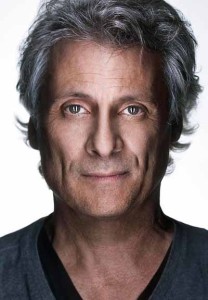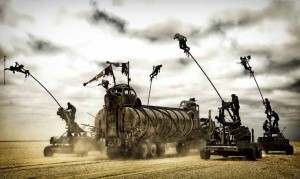![]()

Mangini, who’s worked on Black Mass, Stark Trek (2009), The Fifth Element, and over 100 other titles, came onto the project while the film was beginning its final mix. “I was brought on because George Miller was not happy with the progress of the sound,” said Mangini. “He reached out to me to help right the ship. To get things back on track in a bigger, more spectacular way that was fitting to a Mad Max film.”
Being a fan of Miller’s original films, Mangini knew it was a once in a lifetime opportunity with amazing possibilities for sound. “I was pinching myself as the call came in,” the sound editor recalled.

The heart of the work was to have the audience absolutely believe what they were hearing and seeing was real. “We tried to stay away from artifice,” said Mangini. “We didn’t want to use synthesis in too much of the sound design because it tends to ring untrue, and instead, we used more naturalistic and acoustical sounds.” One aural pitch from Mangini centered on the War Rig, a colossal war machine driven by Furisoa (Charlize Theron). “The Fury Road story reminded me of Moby-Dick. The War Rig is the great whale and Immortan Joe (Hugh Keays-Byrne) is Ahab. We used that as a metaphor – Joe being this crazed captain with the intent on killing the War Rig at all costs. And that propelled all sorts of different sound motifs from a visualization standpoint to the sound work.”
 When the War Rig was attacked by the War Boys, Polecats or Buzzards, whale sounds were laced into the mix. “When you’d see a harpoon skewer the War Rig’s tanker, we’d sweeten it with hump back whales moaning and growling. When liquid would burst from the truck, we would have a whale’s blowhole shooting off,” explained Mangini. “We used these kinds of narrative angles all throughout the sound work. Another simple one is when Max (Tom Hardy) finally comes up to the truck where he sees the girls spraying themselves with water. At that point, the track becomes very spare because that’s all the story is about. We wanted to highlight the sound of just the water because that’s all Max is keyed in on.”
When the War Rig was attacked by the War Boys, Polecats or Buzzards, whale sounds were laced into the mix. “When you’d see a harpoon skewer the War Rig’s tanker, we’d sweeten it with hump back whales moaning and growling. When liquid would burst from the truck, we would have a whale’s blowhole shooting off,” explained Mangini. “We used these kinds of narrative angles all throughout the sound work. Another simple one is when Max (Tom Hardy) finally comes up to the truck where he sees the girls spraying themselves with water. At that point, the track becomes very spare because that’s all the story is about. We wanted to highlight the sound of just the water because that’s all Max is keyed in on.”
Many of the vehicles in the film were characters of their own and it was up to post to make them as big and as gnarly as possible. Helping to set that plate was production sound mixer Ben Osmo and vehicle recordist Oliver Machin. “All of those vehicles are real and on some level evolve out of the gearhead culture of hopped-up V8 engines and big exhausts,” Mangini said. “Ben and Oliver recorded the hell out of every single vehicle in the desert and gave us an amazing starter library to help build their sounds. Then we embellished them into bigger, broader sounds.” Even with substantial library production created, post kept to their mantra of layering vehicle sounds with animalistic qualities. Near the climax of the film, Nux (Nicholas Hoult), ends up sacrificing himself and flips the War Rig to save Furiosa and the girls. To impact the War Rig’s demise, sound infused whale and bear screams to the track instead of metal for its final defeat.
 The music by Tom Holkenborg played heavily into the final mix as well. “To credit George, Tom was brought on really early to begin developing the score,” said Mangini. This is a godsend to sound because the final music is there to work against. It creates a greater harmony and symbiosis in the sound track. “Tom worked from the very beginning with our sound design and vice-versa. He’s an unbelievable, self-facing composer. We developed this wonderful relationship and respect for each other and we met every morning for coffee to talk about and look at the sound challenges. We had a very collaborative way of looking at the mix. He would notice something in our premix and would want to dip some of the music or take drums out because he liked what we were doing with the machine guns, or I would hear some annoying tone in the engines that clashed with tonalities in the score and would remove them. The process we had was quite rare in that we shared everything. We ended up carrying that same philosophy over to the next project we did together, Black Mass.”
The music by Tom Holkenborg played heavily into the final mix as well. “To credit George, Tom was brought on really early to begin developing the score,” said Mangini. This is a godsend to sound because the final music is there to work against. It creates a greater harmony and symbiosis in the sound track. “Tom worked from the very beginning with our sound design and vice-versa. He’s an unbelievable, self-facing composer. We developed this wonderful relationship and respect for each other and we met every morning for coffee to talk about and look at the sound challenges. We had a very collaborative way of looking at the mix. He would notice something in our premix and would want to dip some of the music or take drums out because he liked what we were doing with the machine guns, or I would hear some annoying tone in the engines that clashed with tonalities in the score and would remove them. The process we had was quite rare in that we shared everything. We ended up carrying that same philosophy over to the next project we did together, Black Mass.”
When Mangini came on to the project, he noticed the mix had the best of everything. Almost a gluttony of good material. “The mix had grounded to a halt and there was no way to effectively find the material among so many great elements because of technical restrictions of the console we were working on. We resorted to a variety of technical gymnastics to funnel the overwhelming amount of material so rerecording mixers Chris Jenkins and Gregg Rudloff could actually mix efficiently,” Mangini explained. “If we had 2000 channels of sound, the console could only handle 500, so we re-engineered the system so it could handle the load, but with severe compromises in our ability to find focus.”
 In doing so, the team saw a dramatic improvement from their first screening. “The first pass of the final mix was good, but I didn’t think it was great. We had to get it finished for an audience preview and we struggled to complete the first pass. We ended up showing the film and got a decent preview score. We then embarked on another six weeks of redesign and remixing. We tested the film a second time and the scores went up eight points – and that’s a huge jump,” said Mangini. “It’s a 10% increase in score. That’s a quantifiable number that translates into box office dollars. Nothing was different about the film besides the reimagined sound work. It validated and verified the value and the importance of sound to a film. Having done that re-affirmed my belief, at least in a soft science kind of way, in the importance of what I do and it’s affect on the success of a film. We improved the sound track and the audience responded.”
In doing so, the team saw a dramatic improvement from their first screening. “The first pass of the final mix was good, but I didn’t think it was great. We had to get it finished for an audience preview and we struggled to complete the first pass. We ended up showing the film and got a decent preview score. We then embarked on another six weeks of redesign and remixing. We tested the film a second time and the scores went up eight points – and that’s a huge jump,” said Mangini. “It’s a 10% increase in score. That’s a quantifiable number that translates into box office dollars. Nothing was different about the film besides the reimagined sound work. It validated and verified the value and the importance of sound to a film. Having done that re-affirmed my belief, at least in a soft science kind of way, in the importance of what I do and it’s affect on the success of a film. We improved the sound track and the audience responded.”
For Mangini, the experience was quite rejuvenating. “Sound is a narrative storytelling tool, and by the end, George told us that he had no idea how much sound could help tell his story. He is a savvy director who relies on sound as a narrative tool but he was quite impressed with how far we took his film. It was a real acknowledgment by arguably the greatest filmmakers of our generation on the importance of sound in a moving story.”





